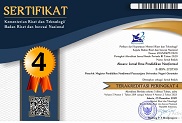Terapi Kelompok dengan Pendekatan Cognitive Behavioral Therapy (CBT) untuk Mengurangi Insomnia
Abstract
Keywords
Full Text:
PDFReferences
Blom, K., Tarkian Tillgren, H., Wiklund, T., Danlycke, E., Forssén, M., Söderström, A., Johansson, R., Hesser, H., Jernelöv, S., Lindefors, N., Andersson, G., & Kaldo, V. (2015). Internet-vs. group-delivered cognitive behavior therapy for insomnia: A randomized controlled non-inferiority trial. Behaviour Research and Therapy, 70, 47-55. https://doi.org/10.1016/j.brat.2015.05.002
Bootzin, R. R., & Epstein, D. R. (2011). Understanding and treating insomnia. Annual Review of Clinical Psychology, 7(1), 435-458. https://doi.org/10.1146/annurev.clinpsy.3.022806.091516
CDC. (2017). Data and statistics: Sleep disorder. Centers for disease control and prevention. https://www.cdc.gov/sleep/data_statistics.html
Cunnington, D., Junge, M. F., & Fernando, A. T. (2013). Insomnia: Prevalence, consequences and effective treatment. Medical Journal of Australia, 199(S8). https://doi.org/10.5694/mja13.10718
Fernandez-Mendoza, J., & Vgontzas, A., N. (2013). Insomnia and its Impact on Physical and Mental Helath. Curr Psychiatry Rep, 15, 418. https://doi.org/10.1007/s11920-013-0418-8
Ho, F. Y.-Y., Chung, K.-F., Yeung, W.-F., Ng, T. H., Kwan, K.-S., Yung, K.-P., & Cheng, S. K. (2015). Self-help cognitive-behavioral therapy for insomnia: A meta-analysis of randomized controlled trials. Sleep Medicine Reviews, 19, 17-28. https://doi.org/10.1016/j.smrv.2014.06.010
Hysing, M., Pallesen, S., Stormark, K. M., Lundervold, A. J., & Sivertsen, B. (2013). Sleep patterns and insomnia among adolescents: A population-based study. Journal of Sleep Research, 22(5), 549-556. https://doi.org/10.1111/jsr.12055
Iqbal, N. (2015). Hubungan Insomnia sebagai Faktor Resiko Terjadinya Hipertensi di Wilayah Kerja Puskesmas Gang Sehat Kecamatan Pontianak Selatan. Jurnal Mahasiswa PSPD FK Universitas Tanjungpura. Vol. 3, No.1
Javaheri, S., & Redline, S. (2017). Insomnia and Risk of Cardiovascular Disease. Chest. Volume 152, Issue 2, Pages 435-444. https://doi.org/10.1016/j.chest.2017.01.026.
Kementerian Kesehatan RI. (2003). Pedoman penggolongan dan diagnosis gangguan jiwa di Indonesia (PPDGJ) (3rd ed.). Dirjen Pelayanan Medis RI.
Kementerian Kesehatan RI. (2013). Riset kesehatan dasar (Riskesdas). Kementerian Kesehatan Republik Indonesia.
Koffel, E. A., Koffel, J. B., & Gehrman, P. R. (2015). A meta-analysis of group cognitive behavioral therapy for insomnia. Sleep Medicine Reviews, 19, 6-16. https://doi.org/10.1016/j.smrv.2014.05.001
Lovato, N., Lack, L., Wright, H., & Kennaway, D. J. (2014). Evaluation of a brief treatment program of cognitive behavior therapy for insomnia in older adults. Sleep, 37(1), 117-126. https://doi.org/10.5665/sleep.3320
Lubis, N. L., & Othaman, M. H. (2012). The effects of cognitive behavorial therapy group and social support group on the self-esteem among breast cancer patients. Makara Kesehatan, 15(2), 65-72.
Melo, D. L. M., Carvalho, L. B. C., Prado, L. B. F., & Prado, G. F. (2019). Biofeedback therapies for chronic insomnia: A systematic review. Applied Psychophysiology and Biofeedback, 44(4), 259-269. https://doi.org/10.1007/s10484-019-09442-2
Morin, C. M., Belleville, G., Bélanger, L., & Ivers, H. (2011). The insomnia severity index: Psychometric indicators to detect insomnia cases and evaluate treatment response. Sleep, 34(5), 601-608. https://doi.org/10.1093/sleep/34.5.601
Norell-Clarke, A., Jansson-Fröjmark, M., Tillfors, M., Holländare, F., & Engström, I. (2015). Group cognitive behavioural therapy for insomnia: Effects on sleep and depressive symptomatology in a sample with comorbidity. Behaviour Research and Therapy, 74, 80-93. https://doi.org/10.1016/j.brat.2015.09.005
Ohayon, M. M. (2011). Epidemiological overview of sleep Disorders in the general population. Sleep Medicine Research, 2(1), 1-9. https://doi.org/10.17241/smr.2011.2.1.1
Parsons, C. E., Zachariae, R., Landberger, C., & Young, K. S. (2021). How does cognitive behavioural therapy for insomnia work? A systematic review and meta-analysis of mediators of change. Clinical Psychology Review, 86, 102027. https://doi.org/10.1016/j.cpr.2021.102027
Sateia, M. J. (2014). International classification of sleep disorders-third edition. Chest, 146(5), 1387-1394. https://doi.org/10.1378/chest.14-0970
Sivertsen, B., Vedaa, Ø., Harvey, A. G., Glozier, N., Pallesen, S., Aarø, L. E., Lønning, K. J., & Hysing, M. (2019). Sleep patterns and insomnia in young adults: A national survey of Norwegian university students. Journal of Sleep Research, 28(2). https://doi.org/10.1111/jsr.12790
Utoyo, D., Jaya, E. S., Arjadi, R., Hanum, L., Astri, K., & Putri, M. D. D. (2013). Preliminary Study on the Effectiveness of short sroup cognitive behavioral therapy (GCBT) on Indonesian older adults. PLoS ONE, 8(2), e57198. https://doi.org/10.1371/journal.pone.0057198
Winkelman, J. W. (2015). Insomnia Disorder. New England Journal of Medicine, 373(15), 1437-1444. https://doi.org/10.1056/NEJMcp1412740
Yalom, I. D., & Leszcz, M. (2020). The theory and practice of group psychotherapy (Sixth edition). Basic Books.
DOI: http://dx.doi.org/10.37905/aksara.9.2.1039-1048.2023
Refbacks
- There are currently no refbacks.
Copyright (c) 2023 Aksara: Jurnal Ilmu Pendidikan Nonformal

This work is licensed under a Creative Commons Attribution-ShareAlike 4.0 International License.
Publisher:
Magister Pendidikan Nonformal Pascasarjana Universitas Negeri Gorontalo
Jl. Soedirman No. 06 Gorontalo 96128 e-mail: jurnalaksara@ung.ac.id
http://ejurnal.pps.ung.ac.id







